1. waterless urinals
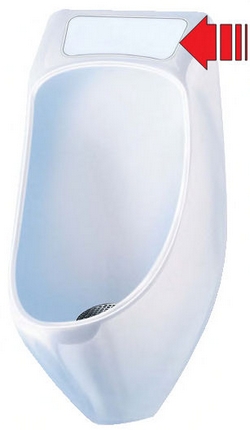
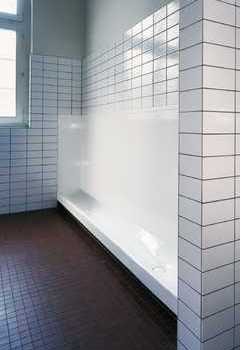
Waterless instead of waterfree because you’ll always need some liquid to clean the system, but still: water is such a valuable resource – too valuable to flush it down the toilet. And while some systems require a liquid in order to transport any faeces and urine (~ waste water, sewerage), the urinals for men could easily be switched from flushing urinals to waterless urinals. These technologies work in any country and culture (!), are already available (PDF) at different technology levels (simple & cheap <=> complex & expensive) and are just as “smelly” as any other flush toilet (or even less!).
The image on top left comes from a brochure @ Urimat.com, a very inovative company that just won numerous prices for their urinal designs. Please note the read arrow which highlights the advertisment area. Now just think of the adopt-a-light concept and you’ll get the idea: public toilets that offer free sanitation and are financed through advertisment and a possible sale of urine as fertilizer (in case of waterless urinals with urine diversion). With an average exposure time of 40 seconds, these ads make sense and are read by most (male) customers.
2. cotton (ear) swabs with paper sticks
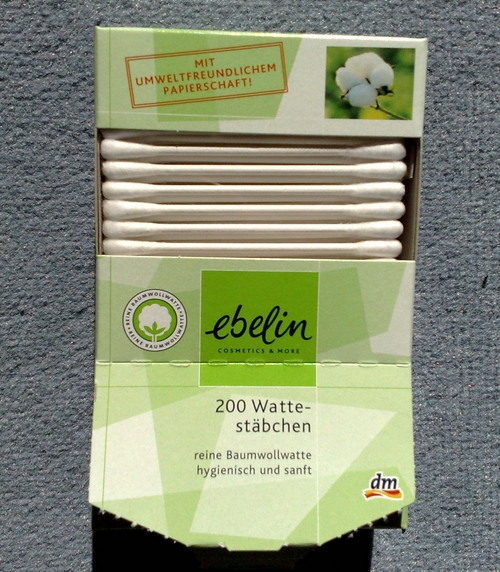
Cotton swabs or Q-Tips made out of rolled paper instead of extruded plastic. Not that the paper approach is such a new invention, but most supermarkets still only sell the plastic version so far. I bought this package as pictured above the other day for EUR 0,55 – the plastic version next to it was 10 €-cents cheaper.
My interest in these is because while working on a treatment plant, I came across HUGE amounts of plastic sticks from Q-Tips in various pumpes and pipes which had to be cleaned daily because of these plastic items some people out there for some strange reason still keep on disposing of through the toilet. I’ve blogged about this earlier here and here, and since you’ll never be able to change the human behaviour, the only solution obviously is to change the way these products are made. Rolled paper is more likely to dissolve in (waste) water than plastics, and bioplastics may at this time still be too expensive for such a usage.
(the Wikipedia entry says that the rolled paper version is still the most common but since I often only see the plastic version, I wonder on which facts this assumption is based? plastic sticks aren’t good, i think).
3. mobile tooth brushes
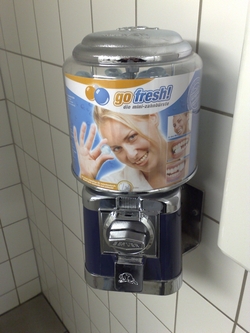
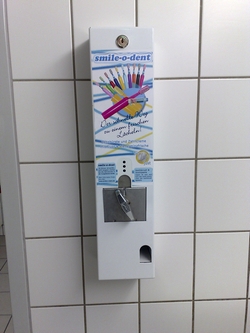
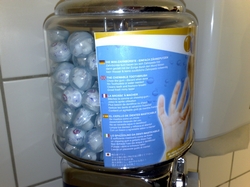
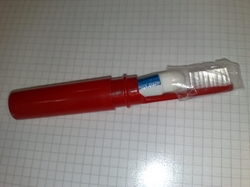
Ok now this is pure luxury, not at all sustainable and I can’t see any environmental friendliness, but these mobile, (one-way) toothbrushes are quite handy for those moments when you just need them. I wonder why their sale is limited (in Germany) to airport restrooms only. One brush with paste sells for EUR 1,-. I bought the one in red and gave it to someone special :-)
tbc…

You…you gave your used toothbrush to another person?
I really like the idea of waterless urinals. All the outdoor cabinet versions I’ve seen (they are really just mobile choo’s) contain a green or blue liquid in the pot, so there is no flush, or that is the flush.
What is that stuff, and is it any more ‘green’ than water? It’s not disinfectant because it has no smell, but it could be some kind of neutralizer because it prevents the booths from smelling as rank as indoor public toilets.
Do you know what that stuff is?
Deja vu on the q-tips?
Paper vs. plastic dissolving in waste is a mislead. I’ve been hearing about this myth my whole life. The reality is that paper makes up the vast majority of waste in landfills, at least over here. Yes, there is true. There’s a researcher who’s been studying trash in landfills for several decades and he proves that paper continues to win-out over plastic as waste.
Tightly rolled paper is probably not going to “melt” any faster than plastic, give or take a few centuries.
What’s really needed is a substance that is sturdy enough for human use, then decomposes nicely once stewing in a landfill for, say, a year. You’re the water/waste management guy, any thing that comes close to this?
A used toothbrush…oh u know I am still a student = no income + sharing a toothbrush is somehow green ^^ (just bought it out of curiosity and then directly forwarded to someone else it in the sealing).
The one on the left is the one-way solution. Produced in the UK, btw – quite popular there, almost unknown in Germany.
>What is that stuff, and is it any more ‘green’ than water? It’s not disinfectant because it has no smell, but it could be some kind of neutralizer because it prevents the booths from smelling as rank as indoor public toilets.
Do you know what that stuff is?<
That green liquid inside the siphon is a chemical smell-stop (“liquid stench barrier”) and valve, but the one Urimat is based on is the most intelligent one I’ve seen. Their’s is based on the urine itself that pushes up a valve inside once the siphon is filled (“hydrostatic float barrier”). Valve floats up and closes the opening. Just smart. There needs to be a constant amount of liquid inside though (i think), which is why it has to be filled up from time to time.
So in order for this to work and also because of patents on the technology used, others have been selling these liquid stench barriers. Problem: expensive, high maintenance and not that eco although the fluid itself is often biodegradable.
>Paper vs. plastic dissolving in waste is a mislead.<
Well, as ppl are still throwing their used q-tips into the sewage, it is more likely that paper may be dissolving in water than plastic, isn’t it`?
>that paper makes up the vast majority of waste in landfills, at least over here.<
YEAH!! Because some States/Counties in the USA do nothing about separation of waste.
There’s a new law btw here in Europe which says that landfills must not contain more than 5% organical material.
>There’s a researcher who’s been studying trash in landfills for several decades and he proves that paper continues to win-out over plastic as waste.<
Oh that’s interesting! I think the USA really have to change a few things on their waste management.
>What’s really needed is a substance that is sturdy enough for human use, then decomposes nicely once stewing in a landfill for, say, a year. You’re the water/waste management guy, any thing that comes close to this?<
Yes. Bioplastics like the one in the blog post the other day and I think even <a href=”http://en.wikipedia.org/wiki/Chitosan” rel=”nofollow”>Chitosan</a> would be suitable for that purpose.
I saw that once, too, I remember. There are teams like that in several places, who investigate the contents of our waste. The subject is called “Garbageology”. In fact, the Deutsches Museum in Munich had (still has?) an exhibition about that as well. Explaining the amount of this-and-that, what we have thrown away 30 years ago and today.
There was something on TV a while ago, too. Actually it was very interesting and surprising. They dug a hole straight down into the dump, more than 26 metres deep. By checking out old newspapers, it is quite simple to find out the date when the appropriate layer of stuff was disposed of. What was really terrible was the fact, that NOTHING organic decays down there; no oxygen, no bacteria.
So they presented 30 year old bread, orange-peels, ketchup… you name it. All there and intact, not even mouldy. After thirty years, nothing had been composted.
On a different occasion, I once saw a footage on TV about cemeteries. You know that most graves are emptied after twenty to fourty years. They dig them up, remove any human remains (mostly fragments of bones and teeth), and dispose of them. Then, after a few more years, the grave can be re-used. Not a nice thought, perhaps, but a necessary measure.
But what sometimes happens, is that they find so called wax-bodies. A phenomenon that happens more and more often. Some bodies will not decay and turn back to earth, but stay intact – so well conserved, that after all those years, even the face is still recognizeable. The reason is that many people, before they finally die, have been on medication for many years. Their bodies are so full of chemicals, that nature can’t deal with it. Fungi, bacteria, worms and bugs don’t like that kind of diet.
So the remains stay in the ground; coffin and clothes will erode away, but the body stays where it is.
The only thing left to do, is to cremate them.
Now this all brings me back to the rubbish-problem. Although paper q-tips seem to be an ecologic solution, I think it’s not worth a thought. The material of which they are made of is not just plain recycled paper, but it is drenched in wax. So it would survive a swim in the toilet bowl for quite a while. And if you think of the amount of q-tips we consume, compared to anything else we have in our bathroom…
It is just too sad but true what you’ve already said: Think of our democracy-and-human-rights-defending friends. They do nothing and don’t take any interest whatsoever for the protection of the environment. To be fair, most countries in the world don’t. I just spent a few days in Mumbai (Bombay) and in Kolkata (Calcutta). Man, I can tell you, the filth and pollution over there is beyond any description.
The truth is: Having a clean, healthy environment is a luxury, which costs a lot of money. Lucky for us we can afford it.
Ich liebe diese wasserlosen Pissdinger! Die stehen bei uns afaik nur an Autobahnraststätten, jedenfalls hab ich sie noch nie woanders gesehen. Wenn man sich davor stellt, geben die ein sattes, zufriedenes “Knack’ulp’chchch” von sich. Was ich schon immer wissen wollte, ist: Woher wissen die Dinger, dass ich davor stehe? Es könnte erstens eine Art lichtempfindlicher Auslöser hinter dem Plexiding sein oder so was wie eine Kontaktschwelle in der Fliese davor. Und was will mir das “Knack’ulp’chchch” eigentlich sagen?
Jedenfalls hab ich Spass wie ein 6jähriger, vor den Dingern auf und ab zu laufen. Wenn ich alleine im “Zimmer” bin und Zeit habe, das urinalspezifische Timing auszubaldowern, mach ich sogar beats damit : )
Das Knachgeräusch kommt bei den Urimat Geräten von einem Magnetschalter, der das Ventil über einen Sensor unterhalb des Beckens (IR Diode, jedenfalls schaut es danach aus) schaltet.
Beats – das erinnert mich an die Scanner letztens, die auch zum Musikmachen umprogrammiert wurden.
@Dave: Thx, bro! You should really compile an article once and I will post it here. Really!
A clean & healthy environment is possible if we start know and a) educate our children on this matter and b) create only products which remain in a technical or biological nutrient cycle. To my perception, there is no such thing as “waste”, but our products have just ended up on the landfill in most cases. So what we need to do is to change all products. I know this is a crazy idea but i think the only option in the long run.